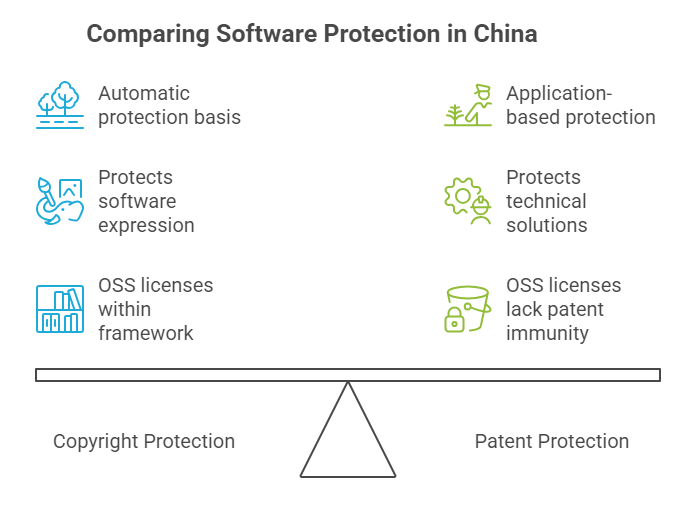The Promise and Peril of Open Source Adoption
Imagine accelerating your software development by integrating powerful open-source components—only to face a costly lawsuit because a hidden patent claim within that “free” code clashes with your product’s core functionality. This scenario is increasingly common for businesses operating in China’s dynamic tech landscape. Open-source software (OSS) offers immense benefits: reduced costs, faster innovation, and collaborative development. However, the intersection of OSS licenses (primarily copyright-based) with China’s robust patent system creates unique legal complexities. Failure to navigate this terrain can lead to infringement claims, project delays, and significant financial liability. Understanding how copyright and patent rights interact within China’s legal framework is crucial for any enterprise leveraging OSS.

The Legal Pillars: Copyright vs. Patent Protection in China
China provides distinct yet potentially overlapping protection for software:
- Copyright (Automatic Protection):
- Basis: Governed primarily by the Copyright Law of the People’s Republic of China (2020 Amendment).
- Protection Scope: Arises automatically upon the creation of original software expression (source code, object code, structure, sequence, organization). Registration with the China National Copyright Administration (CNCA) is voluntary but serves as strong evidence in disputes.
- OSS Licenses: These operate within the copyright framework. By using OSS, users accept the license terms, which grant specific permissions (like use, modification, distribution) while imposing conditions (like providing source code for GPL-licensed code, attribution). Violating these terms constitutes copyright infringement.
- Patents (Application-Based Protection):
- Basis: Governed by the Patent Law of the People’s Republic of China (2020 Amendment) and its implementing rules.
- Protection Scope: Protects technical solutions embodied in software – methods, processes, functions, or systems that solve technical problems and produce technical effects. It requires a formal application and examination process by the China National Intellectual Property Administration (CNIPA).
- Conflict Potential: A piece of software (or a component within it) can be simultaneously protected by copyright (its expression) and patents (its underlying technical inventions). Crucially, OSS licenses generally do NOT grant patent licenses or provide immunity from patent infringement claims, unless explicitly stated within the specific license.
Where Conflicts Ignite: OSS Licenses Meet Chinese Patents
The core conflict arises when the use, modification, or distribution of OSS, permissible under its copyright license, inadvertently infringes upon a third-party patent in China, or when patents cover innovations within the OSS project itself:
- Infringement by Downstream Users: Your company integrates an OSS component into your product. While complying with the OSS license (e.g., providing source code for GPL), your product might perform a function covered by a Chinese patent held by another entity. The OSS license doesn’t shield you from that patent holder’s infringement claim. Example: Using an OSS video codec that implements a technique patented in China by a competitor.
- Patent Ambush within OSS Projects: An individual or company contributes code to an open-source project. Unbeknownst to the project, that contributor later obtains a Chinese patent covering the contributed technique (or had one pending). They can then demand royalties or sue downstream users of the very OSS they contributed to, despite the project’s copyright license.
- License-Specific Patent Clauses (Varied Protection):
- Weak/No Patent Clauses (e.g., GPLv2): These licenses focus almost exclusively on copyright. They offer little to no explicit patent protection for users. GPLv2 has an implicit patent retaliation clause (section 7) but lacks an explicit patent grant from contributors.
- Stronger Patent Clauses (e.g., Apache 2.0, GPLv3):
- Apache 2.0: Includes an explicit, broad grant of patent licenses from contributors only for their specific contributions, covering necessary claims that would be infringed by their contribution alone or in combination with the specific Apache-licensed work they contributed to. It also includes a patent retaliation clause.
- GPLv3: Contains a strong explicit patent license grant from contributors covering their essential patent claims read on the entire Program (the GPLv3-licensed work). It features a robust patent retaliation clause preventing patent aggressors from distributing the software.
- Copyleft vs. Proprietary Code Integration: Combining strong copyleft licensed OSS (like GPL) with proprietary code risks violating the copyleft terms (copyright issue). If the proprietary code implements patented techniques, integrating it with OSS might also trigger separate patent infringement risks unrelated to the OSS license itself.
Mitigating Risks: Proactive Strategies for Compliance
Navigating these conflicts requires diligence and proactive management:
- Rigorous License Audits & Compliance:
- Identify Everything: Use Software Composition Analysis (SCA) tools to create a comprehensive Bill of Materials (SBOM) for all OSS components in your codebase.
- Understand Licenses: Meticulously review the license terms of every component. Pay special attention to copyleft obligations (GPL, LGPL, MPL) and any specific patent clauses (Apache 2.0, GPLv3).
- Establish & Enforce Policies: Implement clear internal policies for OSS usage, contribution, and distribution. Ensure strict adherence to license conditions (source code provision, notices).
- Comprehensive Patent Clearance:
- Conduct FTO (Freedom to Operate) Analysis: Before major product releases or integrating critical OSS, perform searches on CNIPA’s patent databases to identify potentially relevant Chinese patents. This is distinct from checking OSS licenses.
- Analyze Claims: Evaluate the scope of identified patent claims to assess if your implementation (potentially enabled by the OSS) infringes. This requires specialized legal/technical expertise.
- Assess Validity: Consider the strength and potential vulnerability of concerning patents.
- Develop Mitigation Strategies: Options may include design-around solutions, seeking licenses from patent holders, or challenging patent validity (invalidity petition).
- Prioritize FOSS with Strong Patent Provisions: When possible, prefer OSS licensed under Apache 2.0 or GPLv3 for critical components, as they offer more explicit patent grants from contributors and defensive mechanisms.
- Contribution Policies: If your company contributes to OSS projects, establish policies requiring developers to disclose known patents or pending applications related to their contributions. Include agreements granting necessary patent licenses to the project or downstream users.
- Seek Professional Expertise: Navigating Chinese IP law, especially the patent-OSS intersection, is highly complex. Partnering with experts specializing in Chinese intellectual property law and OSS compliance is essential for thorough risk assessment and mitigation. Professional services specializing in Chinese intellectual property due diligence can provide critical support, including in-depth patent landscape analysis, FTO assessments, and tailored compliance strategies. Explore our specialized IP verification solutions to safeguard your projects.
China’s Evolving Landscape: Awareness and Enforcement
Chinese courts have increasingly recognized software-related patents. Landmark cases have also addressed GPL violations, affirming that non-compliance constitutes copyright infringement. While explicit case law on the patent/OSS copyright clash is still developing, the legal principles are clear: an OSS license does not automatically negate patent rights. CNIPA and the courts take both copyright (including license compliance) and patent rights seriously. The 2021 Copyright Law amendments and 2020 Patent Law amendments further strengthened enforcement mechanisms and damages.
Conclusion: Vigilance is Key to Open Source Success in China
Leveraging open source in China offers tremendous advantages but demands heightened awareness of the intricate interplay between copyright licenses and patent rights. Blind reliance on an OSS license alone is a recipe for risk. Success requires a dual-track strategy: meticulous adherence to OSS license obligations (copyright compliance) and proactive management of patent-related risks through thorough FTO analysis and strategic planning. By understanding the legal frameworks, identifying potential conflict points, and implementing robust compliance and clearance practices, businesses can harness the power of open source while minimizing legal exposure and securing their innovations in the competitive Chinese market. Understanding your Chinese partner’s IP landscape, including their use of OSS, is fundamental to mitigating joint risk. Ensure comprehensive due diligence for secure collaborations.
